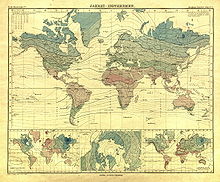Image fusion

The image fusion is a form of representation, for example, in meteorology and medical imaging is used. Series of images of different image modalities are combined into a new series in order to combine the respective advantages. In the background, the merged image usually contains the image information of a modality with high anatomical detail resolution, such as, for example, from computed tomographic or magnetic resonance tomographic recordings.
A series of images (often in color) is superimposed or faded in in the foreground, containing functional image data with little anatomical information. These can be, for example, positron emission tomography , SPECT or fMRI images. With weather maps, the air pressure, wind speeds or cloud cover are superimposed on a map in order to make the data regionally assignable.
If the assignment of image modalities to be merged to corresponding image points cannot be carried out using identical recording parameters, an image registration must take place before the image fusion . Various mathematical methods exist for this.
Web links
- Bernd Hamm: Image Postprocessing Office Clinical Image Fusion. Charité - Universitätsmedizin Berlin - Campus Virchow-Klinikum - Clinic for Radiation Medicine, 2005, accessed on July 20, 2009 .
- A.-J. Lemke: Clinical use of the digital retrospective image fusion of CT, MRT, FDG-PET and SPECT. (PDF; 279 kB) Charité - Universitätsmedizin Berlin - Campus Virchow-Klinikum - Clinic for Radiation Medicine, 2004, accessed on July 20, 2009 (German, English).

